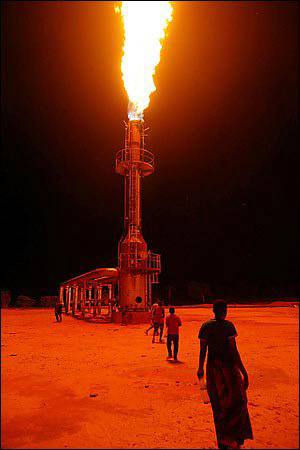“Across Nigeria's oil-rich Niger Delta,” we read, “hellish towers of fire throw an auburn glow, scorching the communities that live under them and sending dark columns of smoke into the sky.”

Which you can have a front row seat for at a brothel-tavern called “One For the Road.” Across from the 200-foot high columns of flames that leap and roar from a tangle of pipelines, its proprietress complains(?): “It is always like this. Every day, every night. We no get darkness.”
The flares have been illuminating the landscapes since the 1970s, residents say, night and day continuously, because Nigeria has not built the infrastructure to make use of one of the world's largest reserves of natural gas. So rather than putting it to use, the fuel is burned off, or flared.
A colleague pointed me to the article I linked to above. He wrote: “While it is essential to recognize and address the issues of environmental justice present here, it is also important to acknowledge the power of the spectacle. Obvious references are to the work of Richard Haag, Julie Bargmann, and Peter Latz. Environmental justice demands that these facilites not spew their toxicity on populations who derive little benefit from them, but a sense of environmental poetic justice, or of economic transparency, would demand that these facilites somehow be visually integrated into the societies they serve. Why should societies whose lifestyle depends on oil be deriving their aesthetic templates from a pastoral economy. Let the derricks and flares dot the distant hillsides! The follies in the distance are likely poly-resin anyway.”
Let's call Cai Quo-Qiang for sure then.